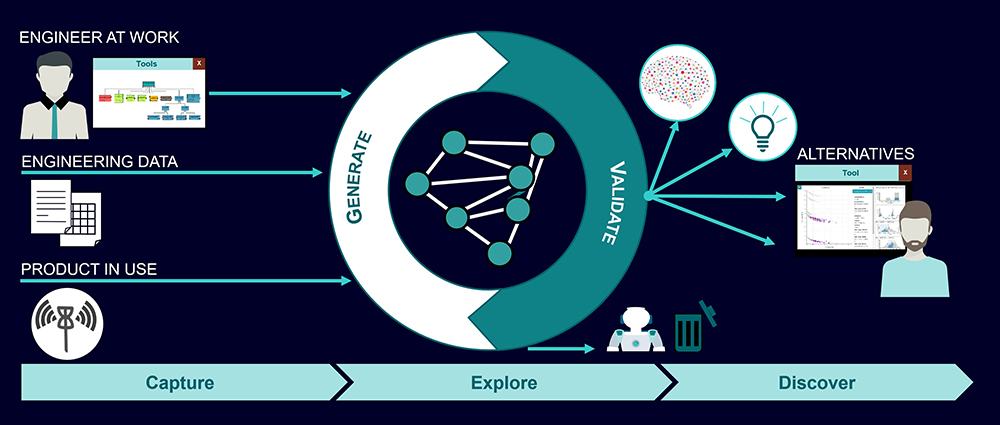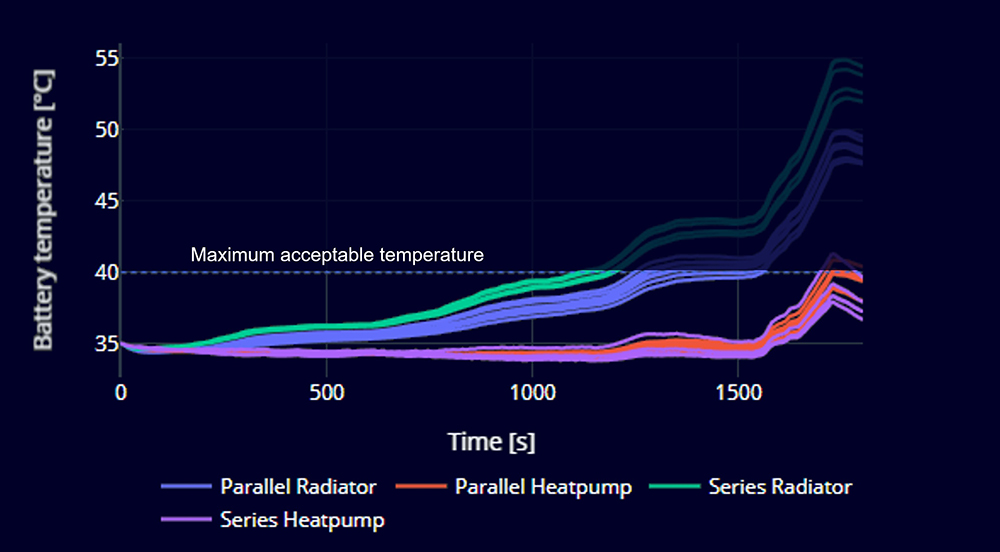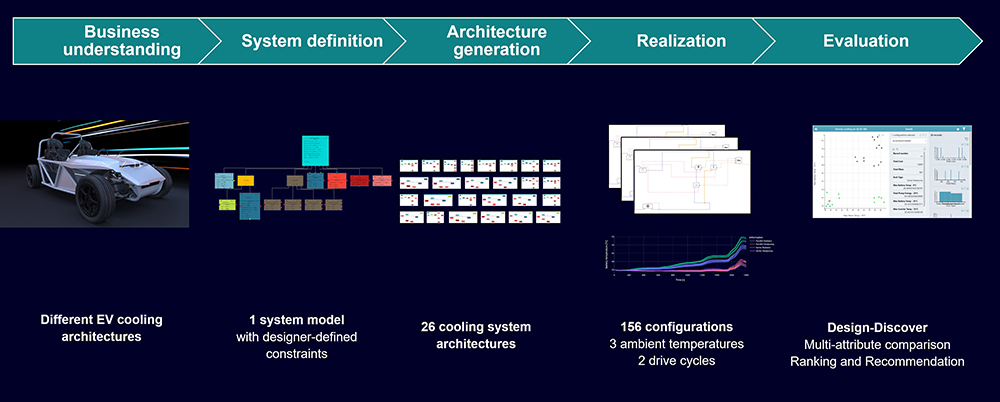
[ad_1]

Sponsored by Siemens.
Make knowledgeable design choices early on by quantifying thousands and thousands of architectures just about
Structure evaluation, whether or not it’s a powertrain structure or a cooling system structure, ensures that the system architectures are aligned with desired necessities and that each one the probabilities are totally explored. It’s a necessary facet of Mannequin-Primarily based Methods Engineering, (MBSE), an strategy the place all necessities are captured and transformed right into a mannequin exhibiting the connection between operate and necessities. On this article, we are going to discover an structure evaluation method with generative engineering inside the realm of MBSE. We will even showcase a case examine of cooling structure evaluation for electrical autos (EVs) to exhibit the sensible software of those methods.
The present cutting-edge in automotive structure choice typically includes a time-consuming and iterative strategy of evaluating and refining ideas primarily based on previous experiences and knowledgeable judgment. This course of could be subjective, susceptible to biases, and restricted by the information and experiences of the people concerned. It might additionally overlook sure trade-offs and system interactions that may considerably affect the general efficiency and effectivity of the automotive structure. As automotive methods grow to be extra advanced, interconnected, and technologically superior, there’s a rising want for a extra systematic and complete strategy to idea choice that goes past the restrictions of the present cutting-edge.
Producing concepts sooner and bringing merchandise to market extra rapidly
Generative engineering is an iterative design and engineering course of that makes use of AI to generate outputs primarily based on a set of standards. It permits engineers to rapidly iterate and choose the perfect design choices. It’s significantly beneficial for fixing tough issues, resembling early architectural design explorations.
Generative Engineering in structure exploration is complemented by trade-off simulation & evaluation, which quantifies the advantages and disadvantages of architectural alternate options, resulting in extra knowledgeable design choices. By creating digital fashions and subjecting them to simulated eventualities, engineers can assess system efficiency and different key attributes. Simulations allow the analysis of architectural alternate options beneath varied situations, offering a complete understanding of system conduct.
Simcenter Studio software program from Siemens affords generative engineering options that assist producers make a holistic evaluation of different system architectures. A group of consultants from a number of disciplines inside your group can work collectively to include a broad vary of necessities and tie them to simulation or check, to outline a system mannequin. From that central mannequin, the software program robotically explores each potential different system structure, intelligently rating and selling them to make sure you make your choice from the perfect choices out there.
Generative engineering includes systematically producing and evaluating a variety of architectural alternate options inside predefined constraints. This strategy encourages creativity and innovation by uncovering novel configurations that will not have been thought-about utilizing conventional strategies. Engineers can manually discover the design area or leverage automated algorithms to find optimum designs.
For extra data on how AI-driven MBSE may also help to discover a really modern route on the very earliest phases of your design cycle, learn this weblog publish: MBSE pushed by AI – shake that design fixation!
Exploring different structure evaluation of cooling methods for an electrical automobile
Environment friendly cooling methods are important to keep up optimum efficiency and forestall injury to delicate elements.
The automobile structure evaluation of inside combustion engines typically focuses on optimizing a single cooling goal, resembling sustaining a particular temperature vary for the engine. Nevertheless, for an electrified automobile, there are a number of elements that must be maintained at totally different temperatures. The cooling system now must serve many targets and aims. The engine nonetheless must be maintained at 95 C° however the lithium-ion battery is at round 35 C° and the electrical motor someplace within the center, round 65 C°. Embracing multi-objective optimization methods permits engineers to contemplate further aims, resembling minimizing vitality consumption and lowering system complexity.
Utilizing a model-based strategy, engineers can create a digital illustration of the electrical automobile and its cooling system in a system simulation device resembling Simcenter Amesim. This mannequin consists of parameters resembling ambient temperature, battery temperature, weight, and value. By subjecting the mannequin to varied simulated driving eventualities, your engineers can consider totally different cooling architectures and assess their efficiency beneath totally different working situations.
Robotically evaluating EV cooling design alternate options
At its core, generative engineering begins by capturing the necessities and constraints of a particular downside or system. These necessities may embody elements like efficiency targets, security rules, materials limitations, or price targets. By inputting these parameters into the generative engineering framework, engineers create a design area that may be systematically explored.

Utilizing superior algorithms, generative engineering generates a wide selection of design alternate options that fulfill the required necessities. These designs are sometimes modern and unconventional, stretching past the boundaries of what human designers would possibly conceive. By exploring this huge design area, engineers can uncover novel options that have been beforehand unknown or unexplored.
Simcenter Studio’s use of AI in generative engineering permits Siemens to design the thermal cooling system structure for the demonstrator electrical automobile, Simrod, which was optimized for energy consumption, price, and weight. This technique leverages superior algorithms and computational fashions to discover an unlimited design area and determine optimum options.
With generative engineering we created quite a few designs that operated inside specified temperature limits whereas delivering environment friendly efficiency. By contemplating three totally different temperature eventualities and two drive cycles, this course of allows complete analysis and robustness evaluation.
Via generative engineering, varied design parameters resembling warmth exchanger configurations, coolant circulate charges, and fan placements are systematically explored and iterated upon. The algorithms intelligently generate and consider quite a few design alternate options, optimizing for energy consumption, price, and weight concurrently.

The ensuing thermal cooling system structure for the Simrod was in a position to obtain a fantastic stability between thermal efficiency and useful resource effectivity. It affords enhanced cooling capabilities, guaranteeing temperature management beneath totally different situations, whereas additionally minimizing energy utilization, lowering prices, and sustaining a light-weight profile. Generative engineering allowed our engineers to effectively and successfully design a complicated thermal cooling system that met numerous necessities and outperformed conventional design approaches.

The way to take most benefit of AI-driven generative engineering
Generative AI is an unbelievable know-how, but it surely’s nonetheless only a know-how. To take most benefit of it, firms have to rewire to allow them to quickly develop options, enhance their buyer expertise, speed up innovation, and cut back prices.
In case you expertise challenge backlogs or want simulation functionality , you possibly can companion with Simcenter Engineering and Consulting consultants to fulfill your distinctive wants. The group brings vital experience to your course of with confirmed product design providers that handle your most important growth challenges.
In conclusion, different structure evaluation methods provide beneficial enhancements to conventional strategies of feasibility evaluation and structure definition stage in Mannequin-based System Engineering. Embracing generative engineering and system simulation can considerably enhance the effectivity and effectiveness of the structure evaluation course of. By incorporating these approaches into the Mannequin-Primarily based Methods Engineering framework, engineers can optimize system efficiency, make knowledgeable design choices, and finally create sturdy methods that efficiently fulfill a number of aims a lot early within the growth course of. These different methods foster innovation and elevate the general high quality of system design.
[ad_2]